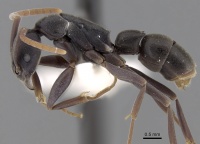Platythyrea bidentata
| Platythyrea bidentata | |
|---|---|
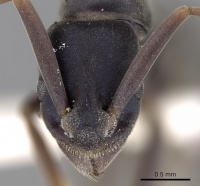
| |
| Scientific classification | |
| Kingdom: | Animalia |
| Phylum: | Arthropoda |
| Class: | Insecta |
| Order: | Hymenoptera |
| Family: | Formicidae |
| Subfamily: | Ponerinae |
| Tribe: | Platythyreini |
| Genus: | Platythyrea |
| Species: | P. bidentata |
| Binomial name | |
| Platythyrea bidentata Brown, 1975 | |
The types were found in the Cuernos Mountains and another collection was from a forest fragment in Sorong.
| At a Glance | • Gamergate |
Identification
Brown (1975) - P. bidentata is most closely related to Platythyrea clypeata, but the new species has a much more deeply excavated posterodorsal petiole border, forming 2 blunt posterior teeth much like those of Platythyrea quadridenta. The color of bidentata is also much darker than in the two known clypeata (including thwaitesi) specimens, both of which are isolated winged queens, and hence unlikely to be callow. P. quadridenta and P. sagei have blunt but distinct propodeal teeth, lacking in bidentata.
Keys including this Species
Distribution
Distribution based on Regional Taxon Lists
Indo-Australian Region: Philippines (type locality).
Distribution based on AntMaps
Distribution based on AntWeb specimens
Check data from AntWeb
Countries Occupied
| Number of countries occupied by this species based on AntWiki Regional Taxon Lists. In general, fewer countries occupied indicates a narrower range, while more countries indicates a more widespread species. |

|
Estimated Abundance
| Relative abundance based on number of AntMaps records per species (this species within the purple bar). Fewer records (to the left) indicates a less abundant/encountered species while more records (to the right) indicates more abundant/encountered species. |

|
Biology
Castes
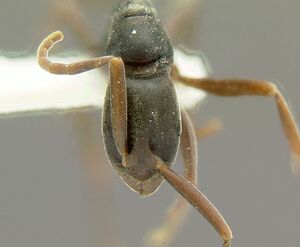 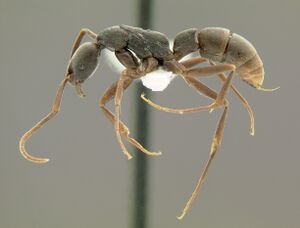 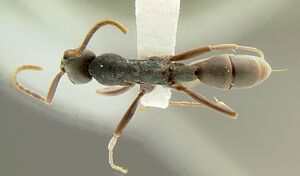
| |
| . | Owned by Museum of Comparative Zoology. |
Nomenclature
The following information is derived from Barry Bolton's Online Catalogue of the Ants of the World.
- bidentata. Platythyrea bidentata Brown, 1975: 51, figs. 26, 28 (w.) PHILIPPINES (Negros I.).
- Type-material: holotype worker, 1 paratype worker.
- Type-locality: holotype Philippines: Negros Oriental, Cuernos Mts, nr Dumaguete, ca 3600 ft, 1942 (J.W. Chapman); paratype with same data but 10.i.1943.
- Type-depository: MCZC.
- Status as species: Bolton, 1995b: 336; Phengsi, et al. 2018: 98 (in key).
- Distribution: Philippines (Negros).
Unless otherwise noted the text for the remainder of this section is reported from the publication that includes the original description.
Description
Worker
Holotype. TL 8.7, HL 1.77 (including clypeus), HW 1.33 Gust behind eyes) (CI 75), ML 0.31, scape L 1.64, greatest scape W 0.26, greatest diameter of eye 0.30, WL 2.84, petiolar node L 1.10, W 0.57 mm.
Head with convex sides and transverse posterior border, very slightly concave, and the cervical margin of the head showing in full-face view. Frontal lobes convex, separated by a shallow, round-bottomed median sulcus that ends posteriad where the lobes pass into the short, round-edged, parallel frontal carinae. Clypeus swollen and strongly convex in the middle in both directions, its free border with a narrow, rounded lamellar apron, broadest toward the middle. Posterior clypeal border fine but reasonably distinct. Mandibles robustly sub triangular, with very slightly convex outer borders and distinct teeth - a larger apical tooth, followed by alternating larger and smaller teeth, but all generally diminishing in size basad; 9 teeth visible, but there are probably one or two small teeth hidden beneath the clypeal margin. A short but distinct groove runs directly anteriad from each mandibular insertion on the dorsal surface near the outer margin, and ends before reaching the outer margin. Eyes only feebly convex, suboval, situated exactly at mid-HL, covered with a pile of minute, erect hairs. Antennal scapes long and robust, thickest beyond midlength; in full-face view when held nearly straight back, surpassing posterior border by about twice their apical thickness. Basal funicular segment equal in L (0.35 mm) to III; segment II much the longest (L 0.50 mm), apical segment L 0.37 mm, weakly curved, with a flattened, narrowly rounded apex.
Pronotum as seen from above subcircular in its anterior 2/3, without margins or humeral angles, separated from mesonotum by the usual distinct and flexible suture. Remainder of trunk with nearly parallel sides (slightly constricted in mesonotal region) 2/3 to ¾ as wide as pronotum. Sutures between mesoscutum, mesoscutellum, and metanotum are nearly effaced but can be made out partly in certain lights as obscurely impressed marks. In side view, the dorsal outline is nearly straight from promesonotal suture to beginning of curve leading into propodeal declivity, except for a slight dip centered in the metanotal region. Declivity convex in side view due to low, bluntly rounded lateral margins; face of declivity subtriangular, concave from side to side, narrowed at the top and extending a short way onto the dorsal surface; indistinctly transversely ruguloso-striate in the middle and lower parts. Propodeal suture distinct through most of its course, especially below the spiracles, which have slit-shaped orifices, about 4 X longer than broad.
Petiolar node upper sides very shallowly impressed (concave) behind midlength, just in front of the bases of the posterodorsal teeth or lobes. Tergum of postpetiolar (first gastric) segment broader than long, rounded strongly in both directions in front, the rounded part overhanging the insertion. Sternum of postpetiolar segment also rounded in front, without process or ridge. Second gastric segment slightly longer, but slightly narrower, than first, but still a little broader than long. Pygidium narrowly rounded.
Legs long and robust; front coxae and femora especially well developed, the femur incrassate in the middle (maximum W about 0.3 XL); hind femur L 1.90, hind tibia L 1.56 mm. Tibial spurs 2 on each middle and hind leg, the lateral spur a little more than half as long as the inner one, all pectinate. Teeth of tarsal claw reduced and difficult to see, especially on first pair of legs.
Sculpture and pilosity of the usual Platythyrea kind; normally exposed surfaces of body, mandibles, and appendages very finely, densely, and shallowly punctulate and pruinose, with fine, short standing hairs on anterior clypeal margin, mandibles, and gastric apex. The surface is in general opaque, but a dull shine can be obtained in certain lights, especially from petiolar node and anterior sides of gaster. The larger punctures or foveolae normally found in Platythryrea are small and subdued in P. bidentata, but can be seen in the right light on the head, particularly mesad of the eyes, on the sides of the pronotum, and less distinctly elsewhere. Color very dark brown, appendages castaneous, shading into reddish yellow at the antennal apex.
Paratype: TL 8.4, HL 1.70, HW 1.23 (CI 72), ML 0.27, scape L 1.55, greatest scape W 0.25, greatest diameter of eye 0.26, WL 2.73, petiolar node L 0.91, W 0.53 mm.
Besides its smaller size and slightly smaller eyes, the para type has a more distinctly impressed area in the region of the suture between meso- and metanotum, and the metanotum itself is slightly raised behind this. The paratype also has some coarse but only moderately distinct, prevailingly longitudinal rugae on the posterior half of the middle sides of the petiolar node.
References
- Brown, W. L., Jr. 1975. Contributions toward a reclassification of the Formicidae. V. Ponerinae, tribes Platythyreini, Cerapachyini, Cylindromyrmecini, Acanthostichini, and Aenictogitini. Search Agric. (Ithaca N. Y.) 5(1 1: 1-115 (page 51, figs. 26, 28 worker described)
- Jaitrong, W., Xu, Z., Khachonpisitsak, S. 2022. A new species of the ant Platythyrea clypeata species group (Hymenoptera, Formicidae, Ponerinae) from continental Asia. ZooKeys 1115, 151–168 (doi:10.3897/zookeys.1115.86477).
References based on Global Ant Biodiversity Informatics
- Brown W. L., Jr. 1975. Contributions toward a reclassification of the Formicidae. V. Ponerinae, tribes Platythyreini, Cerapachyini, Cylindromyrmecini, Acanthostichini, and Aenictogitini. Search Agric. (Ithaca N. Y.) 5(1): 1-115.
